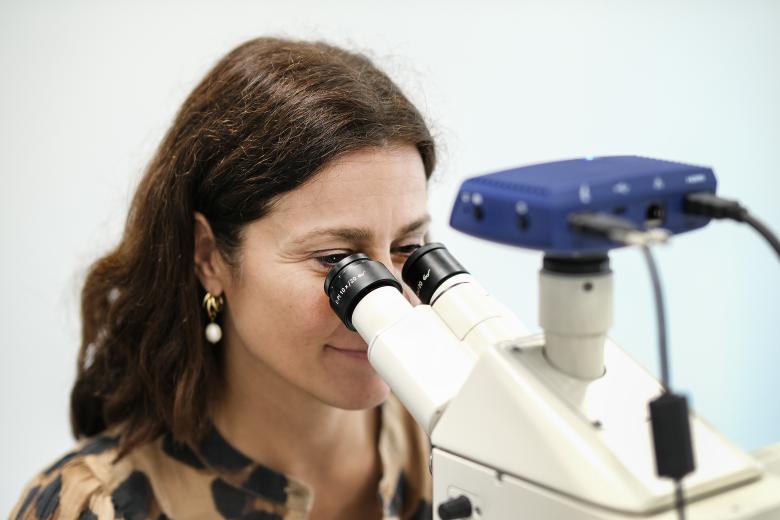Making more bone about it
MERLN’s Sabine van Rijt has won the prestigious ERC Consolidator Grant for her Nano4Bone research project. She aims to develop a new type of biomaterial for bone cancer patients. The composite material based on nanoparticles and polymers will kill remaining cancer cells and instruct the body to regrow surgically removed bone.
Osteosarcoma is a relatively rare bone tumour that has a major impact on patients’ wellbeing. It is usually found in the bigger bones of the body. Often, substantial parts of the affected bone have to be surgically removed while remaining tumour cells are destroyed using radiation or chemotherapy. It is difficult, often impossible, to repair the bone after these interventions and the chance of recurrence is high.
Trying to tackle all of these issues, Sabine van Rijt will develop a nanocomposite biomaterial consisting of a hydrogel and nanoparticles. “Hydrogels are organic polymers that have similar properties to human tissues; they contain a lot of water and are also quite soft.” Hydrogels can be used for soft tissue applications such as skin, but are usually not suitable for stiffer tissue like bones.
Growing back together
Hydrogels can be engineered to be self-healing. After the bonds between the polymers are broken, either because they do so naturally or due to particular stimuli, the gel completely reforms without visible ruptures; it grows back together. “In tissue engineering and regenerative medicine, this is useful because it emulates human tissues’ ability to heal. The tissue can remodel its environment.” Another advantage of self-healing hydrogels is that they can be injected into the damaged site and reformed into any shape to replace the missing tissue. Over time, the material should degrade and be replaced by human tissue.
Van Rijt’s project is innovative in its use of inorganic nanoparticles to form composite materials. “Even though they’re tiny, they have a high surface area and we use this property to form multiple bonds with the polymers of the hydrogel. That makes the gel much stiffer. At the same time these bonds are reversible.” Preliminary data shows that the nanoparticles heavily fortify the hydrogel without diminishing its self-healing properties. “We want to optimise the self-healing materials by tuning bond kinetics, so manipulating the rate at which these bonds form and break.”
The nanoparticles can also give the composite material additional properties. “They are highly bioactive; that means they signal to the surrounding tissue to promote bone formation.” As the material degrades, the nanoparticles are released, taken up by cells and there stimulate tissue formation. The material is thus gradually replaced by actual bone.
Growing back the bone
Van Rijt also managed to modify nanoparticles to have anti-osteosarcoma properties. “We can create particles that are very selective towards bone cancer cells without being overly toxic to other cells, so it has a selective chemotherapeutic effect. We hope to have one kind of nanoparticle that kills the remaining osteosarcoma cells and then a second type promoting the growth of bone. Ideally, they would be released one after the other. In these patients, delivery would not be an issue; surgeons could apply the material right after removing the diseased bone.”
While the nanocomposite biomaterials are developed for application in bone cancer, the research also fundamentally investigates the mechanisms of these novel materials for a much wider range of applications in biomedical science. Nano4Bone, which would also be an excellent name for an R&B quartet, sees many of Van Rijt’s research lines coming together.
Growing around obstacles
Her academic career was everything but linear and led her from Leiden to Vancouver, Edinburgh, Warwick, and Munich. It included a year away from academia and a change of fields. And it didn’t’ start auspiciously. As an atypical learner, Van Rijt had rather average grades in elementary school and was discouraged from pursuing secondary education at the highest level. For the sake of expedience, she chose an economical profile in high school.
“I realised then that I was much more interested in science, so I added an extra year in high school focusing on all the STEM subjects.” This allowed her entry to a university of applied science. While Van Rijt enjoyed conducting experiments, she was even more interested in understanding the underlying workings. Successful completion of the first year enabled her to enter university and study chemistry.
After a PhD and a postdoc in inorganic chemistry, she worked for the Dutch Research Council (NWO) before following her passion for science back into research as she switched to regenerative medicine when coming to UM to work at MERLN. While daunting, this was also motivating. “I love fundamental science but it’s incredibly inspiring to see the purpose, how this will improve people’s lives.”
Growing into the position
The prestigious ERC Consolidator Grant of two million euros over five years will allow her to hire five more researchers to work alongside the six PhD students she’s already supervising. “I found the leadership courses UM has invested in really helpful in dealing with all the diverse tasks including teaching, managing, and administration.”
Van Rijt appreciates the recognition that comes with winning the grant but also points out that this shouldn’t be considered the only way to succeed and that, in any case, it came after a string of unsuccessful applications. “Honestly, it wasn’t’ easy to get where I am today, and there were moments I considered quitting altogether.” She credits internal motivation as the most important factor in facing the hard work and inevitable setbacks. “You have to do what you’re passionate about. It takes so much energy to keep going, so spend as much time as you can on research that gives you back energy.”
By: Florian Raith
Also read
-
The University Fund Limburg's new Annual Fund Campaign is live!
Every year during the holiday season, the UM community comes together to uphold a special tradition: supporting projects that contribute to a healthier, fairer and more sustainable society. Will you join us?
-
SBE researchers involved in NWO research on the role of the pension sector in the sustainability transition
SBE professors Lisa Brüggen and Rob Bauer are part of a national, NWO-funded initiative exploring how Dutch pension funds can accelerate the transition to a sustainable society. The €750,000 project aims to align pension investments with participants’ sustainability preferences and practical legal...
-
Fresh air
Newly appointed professor Judith Sluimer (CARIM) talks about oxygen in heart functioning and the 'fresh air' the academic world needs.